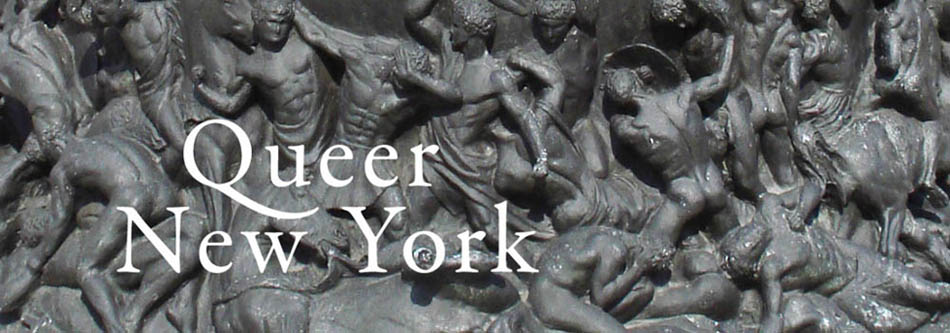I came to New York in August of 1966, a month before my nineteenth birthday. I had grown up in the Deep South, in Savannah, Georgia, and New York was strange to me. It felt immediately huge, rude, cold, and unfriendly. And also, quite ungay. You have to remember, this was only a year after the New York World’s Fair (1964-65), when Mayor Wagner had closed down most of the gay bars in the city to keep hordes of tourists and their families from stumbling innocently into queerness. So the few bars that remained open or were re-opened later by the Mafia (and in this period, Tony Soprano and his cousins ran virtually all gay enterprises in the city) were still vulnerable to shake-downs by the cops.
I’d also been away from home (or at least the city of my birth) for more than a year. In order the escape the South, where I had already come out, and the literal threats of murder I’d had there, I hitchhiked, at the age of 17, after a year of college at the University of Georgia, to San Francisco. Gay Nirvana. This was the interesting period of my real coming out—being a 17-year-old attractive kid on his own in California, where I could not wait 10 minutes for a bus without guys cruising by and trying to pick me up—but it’s another story. So by the time I got to New York, I’d already had somewhat of a life, and New York seemed less than welcoming. But immediately I got a job. In those days it was simple: there were more jobs than people in the city, during the boom period of the mid-60s, and since I had wanted to work, in my naive way, in the “art field,” I got a job as a messenger/apprentice at an art studio in the East 50s.
My second problem was a place to live; this proved easy enough, too. I answered a “Roommate Wanted” ad in the Times and got interviewed by Bob Schwiller, a 42-year-old man who had an large apartment on 64th Street, off Central Park West. Bob was a waiter at a popular but now extinct chain of restaurants, like Schrafts, beloved by ladies who lunched. He was short, balding, trim, and smoked constantly. He talked incessantly and eyed me familiarly.
“You got a real nice body,” he told me off the bat. “But I ain’t interested in that. What I want to know is what kind of guys do you go for?”
This came right out of his mouth, without even asking me if I did go for guys. I guess the fact that I came from Savannah, Georgia, and was 18 (I told him 19) did it. I replied I liked guys who looked like I did: young and attractive.
He lit up, for reasons I’d discover later.
“Great. One gent told me he only went for Negroes. I got nothin' against that, but I couldn’t have it in the house all the time. Know what I mean?” He winked at me, and asked me when I wanted to move in. Since this was my first ad, and he was old (at 18, 42 is old enough for life support), I told him I’d think about it. He smiled, and said, “That’s OK, look around. You’ll be back.”
I went to a few other places advertised: the guys were even more leering and obnoxious than Bob; the apartments either out of my price range or too fussy and prissy; or their hosts simply not eager to have a kid move in. I called Bob back.
I arrived with one suitcase and a sample case of drawings I kept with me. And I quickly discovered the interesting world of Central Park West in New York.
Since so many of the bars had been shut during the World’s Fair, cruising in New York had become primarily an outdoor pursuit, and Central Park West its open-air salon. The focus was on the steady line of benches on the blocks from 60th Street to about 72nd Street, and most evenings, after 7 pm, a chorus of guys was on display there, either watching who was parading up and down the avenue, or moving around themselves.
Activities were mostly sexual, but also social: you could in fact have Central Park West friends to dish and gab with. The pick-up rate was astounding: at times, it was down to about 6 minutes. If you lived close to the area, it was a picnic; and if you didn’t, you could either bring someone back with you by subway, or at make a date for later. My roommate Bob was an accomplished CPW queen, and there were nights when he’d bring home three usually younger men, or, if he felt like it, do them in the Park, which was another way of consummating situations, and most of the time it worked out very well.
You can learn more about Perry Brass at his website, www.perrybrass.com. On April 29, he and Jerry Kajpust will be leading a workshop on The Manly Art of Seduction, based on his book, at the LGBT Center on West 13th Street. You can learn more about this at http://manlyartworkshop2.eventbrite.com



How the geography of New York cruising changes! Those benches along CPW are now used by a few homeless, an occasional nanny with a baby carriage, and sometimes, in the best weather, by me and my husband with our morning coffee.
ReplyDeleteIt's always fascinating to me to hear about NYC when jobs were plentiful and rents were cheap. That alone lets me know how much things have changed. And to think of CPW as once a place one could find deals! Lovely little landscape sketch, Perry. I look forward to more.
ReplyDeleteFabulous Perry welcome home!
ReplyDelete